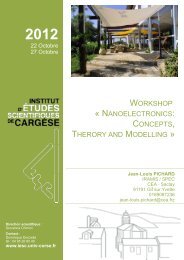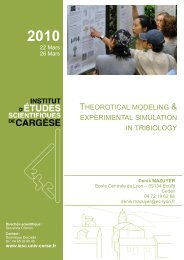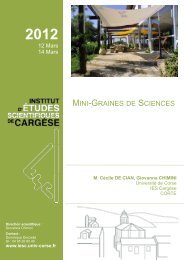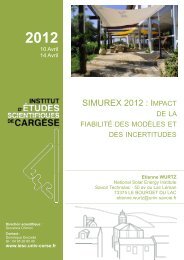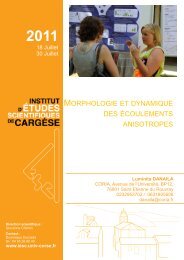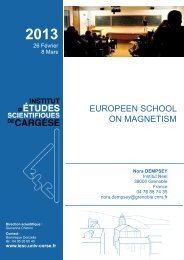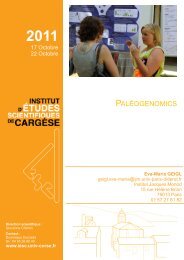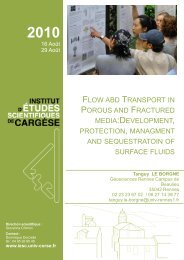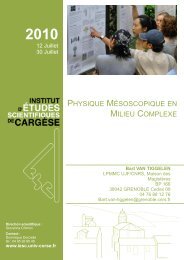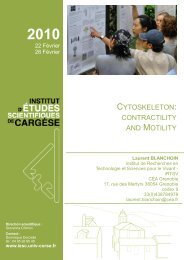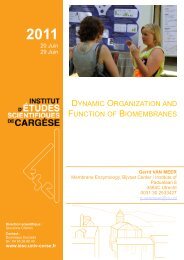Mathias FINK - Institut d'études scientifiques de Cargèse (IESC)
Mathias FINK - Institut d'études scientifiques de Cargèse (IESC)
Mathias FINK - Institut d'études scientifiques de Cargèse (IESC)
Create successful ePaper yourself
Turn your PDF publications into a flip-book with our unique Google optimized e-Paper software.
performing any calculations.<br />
Pr. John H. Page<br />
An<strong>de</strong>rson Localization of Ultrasound in Three-Dimensional Mesoglasses<br />
The question of whether or not the An<strong>de</strong>rson localization of classical waves can really occur in<br />
three-dimensional disor<strong>de</strong>red materials has intrigued physicists for many years. Recently there has<br />
been consi<strong>de</strong>rable progress in answering this question, with the most direct <strong>de</strong>monstration of 3D<br />
An<strong>de</strong>rson localization being first established in acoustics, through measurements of the dynamic<br />
transverse confinement of energy in a “mesoglass” consisting of a disor<strong>de</strong>red elastic network of<br />
aluminum beads [1]. In this approach, an inci<strong>de</strong>nt ultrasonic point source is used, and the spatial<br />
extent of the transmitted intensity is measured as a function of time on the opposite si<strong>de</strong> of the<br />
sample. For diffuse waves, the spatial intensity profile on the sample surface is Gaussian, and the<br />
width squared grows linearly with time. For localized waves, the transverse spreading of the<br />
intensity is cut off, and the width saturates at long propagation times, giving information on the<br />
localization length. Thus, measurements of this dynamic transverse width provi<strong>de</strong> a very direct way,<br />
which is in<strong>de</strong>pen<strong>de</strong>nt of absorption, of distinguishing between diffusive and localized states [1].<br />
After reviewing our initial experiments and their successful interpretation using the self-consistent<br />
theory of localization [2], I will show how the transverse width evolves with time as frequency is<br />
varied, and a mobility edge, separating exten<strong>de</strong>d from localized waves, is crossed. This work is<br />
enabling us to study aspects of classical wave localization near the An<strong>de</strong>rson transition that have<br />
not been amenable to experimental investigation previously, such as the multifractal spatial<br />
structure of localized wavefunctions [3], long-range and even infinite-range correlations of the<br />
intensity with position and frequency [4], and dynamic backscattering phenomena that reveal, in<br />
addition to the effects of localization on time-<strong>de</strong>pen<strong>de</strong>nt coherent backscattering, a surprisingly<br />
large recurrent scattering contribution.<br />
[1] H. Hu, A. Strybulevych, J.H. Page, S.E. Skipetrov and B.A. van Tiggelen, Nature Phys. 4, 945-8<br />
(2008).<br />
[2] N. Cherroret, S.E Skipetrov, and B.A van Tiggelen, Phys. Rev. E 82, 056603 (2010).<br />
[3] S. Faez, Anatoliy Strybulevych, J.H. Page, A. Lagendijk and B.A. van Tiggelen, Phys. Rev. Lett.<br />
103, 155703 (2009).<br />
[4] W.K. Hil<strong>de</strong>brand, A. Strybulevych, S.E. Skipetrov, B.A. van Tiggelen, and J.H. Page,<br />
arXiv:1303.7042.<br />
Pr. Morchedaï Segev<br />
An<strong>de</strong>rson Localization of Light and Beyond<br />
An<strong>de</strong>rson Localization is one of the most basic concepts in solid-state physics. However,<br />
experiments with electronic systems have elu<strong>de</strong>d scientists for many <strong>de</strong>ca<strong>de</strong>s. Three <strong>de</strong>ca<strong>de</strong>s after<br />
An<strong>de</strong>rson’s prediction, the concept has been exten<strong>de</strong>d to optics, and in 2007, our group has ma<strong>de</strong><br />
the first <strong>de</strong>monstration of An<strong>de</strong>rson localization in its original context, where random fluctuations<br />
superimposed upon a periodic structure bring transport to a halt. Many experimental works have<br />
followed, in optics and matter-waves. But can disor<strong>de</strong>r work to increase transport beyond diffusion,<br />
and perhaps even beyond ballistic transport ? The talk will review the recent progress on An<strong>de</strong>rson<br />
localization of light, and will <strong>de</strong>scribe experiments and theory <strong>de</strong>monstrating disor<strong>de</strong>red–enhanced<br />
transport in photonic quasicrystals, and hyper-transport of light in photonic media with evolving<br />
disor<strong>de</strong>r : a new regime of transport in which an arbitrary wavepacket expands at a rate faster than<br />
ballistic.<br />
Pr. Lihong Wang<br />
Synergy between light and sound : photoacoustic tomography and TRUE optical focusing



